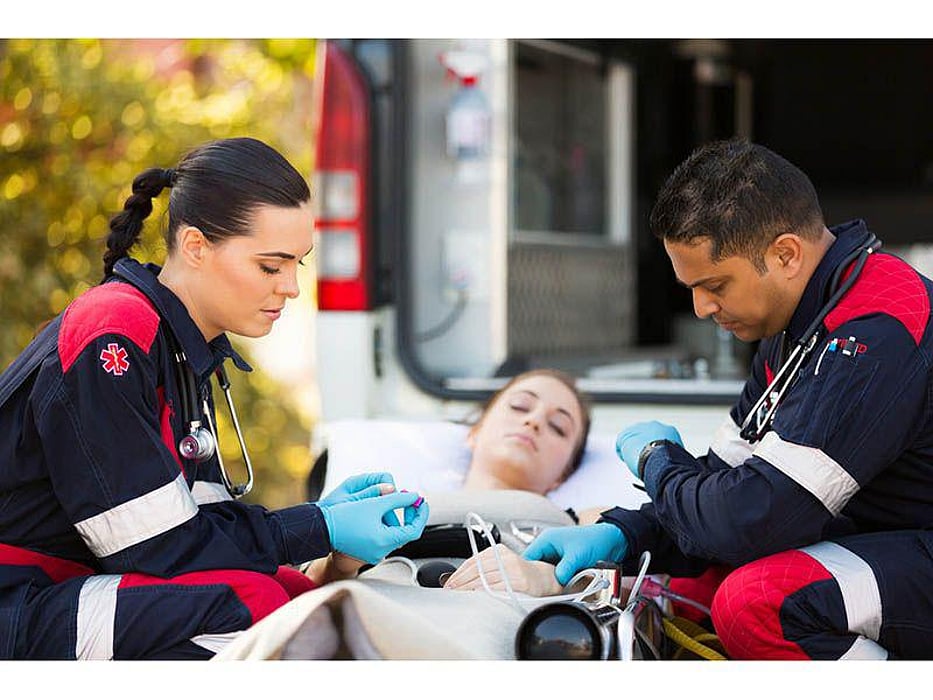Dealing With Medical Emergencies

Medical emergencies can be frightening, especially if you are unprepared. Being familiar with first aid instructions can help you prevent or minimize serious injury. It can even save lives. Knowing what to do will give you the confidence to act calmly and quickly.
How can you be better prepared for emergencies?
Keep a list of emergency numbers by the telephone or on your cell phone. If you have a cell phone, program these numbers into your telephone book:
- Police
- Fire department
- Poison control center
- Local hospital
- Ambulance service
- Family doctor
Make a list of medications you and your family take. Get to know the names of your medicines and why you take each one of them. Note the dosages and how often you are supposed to take them each day. Know the names of all medications that have caused you to have severe allergies in the past. Write all of this information down and keep the list in the medicine cabinet at home, and make a copy to carry in your wallet or purse. In case of emergency, knowing the medications you and your family members are taking will help emergency personnel avoid dangerous drug interactions.
Have basic first aid supplies ready. At least twice a year, check your supplies to be certain they are up-to-date and complete. A basic-first aid kit should include:
- Aspirin, acetaminophen, and ibuprofen (But remember, never give aspirin to children or teens with a cold or fever.)
- Antibiotic ointment
- An over-the-counter antihistamine such as Benadryl
- Bandages
- Cold packs
- Hydrogen peroxide
- Latex gloves
- Rehydrating fluids
- Safety pins
- Scissors
- Soap
- Thermometer
- Tweezers
- Anything you or your family may require for conditions such as diabetes, a heart condition, or a severe allergy.
Keep a first aid kit in your house and in your car, in case you need it when you are away from home. Don't forget to refurbish your car kit yearly, as well as the one in your home.
Prepare for a possible emergency: If you live in an area prone to earthquakes, hurricanes, flooding, or other natural disasters, keep three days' worth of water (estimate a half gallon per person per day), nonperishable food (especially canned or dried products that don't need to be cooked), a first-aid kit, a manual can opener, water purification tablets, flashlights, and other essentials in a watertight container. Put this container in a location you'll be able to reach in the event of a disaster. Check and update the contents twice a year.
Learn CPR (cardiopulmonary resuscitation). The American Red Cross and American Heart Association, along with local fire departments and some hospitals, offer short courses in CPR techniques. Taking the time to learn CPR can mean the difference between life and death. The Red Cross also offers first aid classes in English and Spanish and gives safety classes for children and babysitters.
What should you do during an emergency?
Note: Both the American Red Cross and American College of Emergency Physicians recommend the "AID" rule of thumb: ask for help, intervene, do no further harm.
Make sure the scene is safe. Survey the area for dangers, such as a gas leak, fire, or falling objects. Do what you can to secure the scene and prevent further accidents. You may need to set up flares or markers around an auto accident or move the victim from an unsafe place, away from oncoming cars or fires. However, only move victims if you absolutely must.
Try to determine what happened. Quickly identify the number of victims involved and the extent of their injuries or illnesses. Ask bystanders and look for emergency medical information such as bracelets or cards.
Call for help. The faster you call 911 or local emergency services, the sooner the victim will be treated.
Intervene. Be careful to do no further harm to the victim. Never move anyone who could have a spinal injury, unless the scene is unsafe. Check the person's airway, breathing and circulation. If the victim is not breathing, perform chest compressions immediately. Don't stop until either the patient revives, the rescuer gets too tired to continue, or emergency personnel arrive.
Remain calm and focused. Knowing what to do and having the necessary supplies will give you confidence to act quickly. If you feel yourself panicking, stop and take two or three deep breaths. Count slowly from one to 10. Tell yourself that you can handle the situation. If an injured person is confused or agitated, reassure him or her if possible. Then calmly review what you need to do.
References
American College of Emergency Physicians, First Aid Manual,
The American Red Cross First Aid & Safety Handbook
MayoClinic.com. http://www.mayoclinic.com/findinformation/firstaid...
American College of Emergency Physicians Fact Sheet, www.acep.org
American College of Emergency Physicians. First Aid Kit
American Red Cross. www.redcross.org
Federal Emergency Management Agency. Emergency Planning and Disaster Supplies.
Image: Shutterstock
Related Posts
Could ‘Produce Prescriptions’ Save $40 Billion in Medical Bills Among Those With Diabetes? Study Says Yes
THURSDAY, July 13, 2023 (HealthDay News) -- A bunch of healthy fruits and...
Tick-Borne Powassan Virus Can Kill. What Is It, and How Can You Protect Yourself?
THURSDAY, May 25, 2023 (HealthDay News) – Robert Weymouth, 58, of Portland,...
Mom’s Exercise in Pregnancy May Help Baby’s Lungs
WEDNESDAY, Sept. 8, 2021 (HealthDay News) -- Exercising during pregnancy can...
AHA News: Protecting LGBTQ People From the Health Risks of Social Isolation
FRIDAY, Oct. 21, 2022 (American Heart Association News) -- The ways Donald M....
